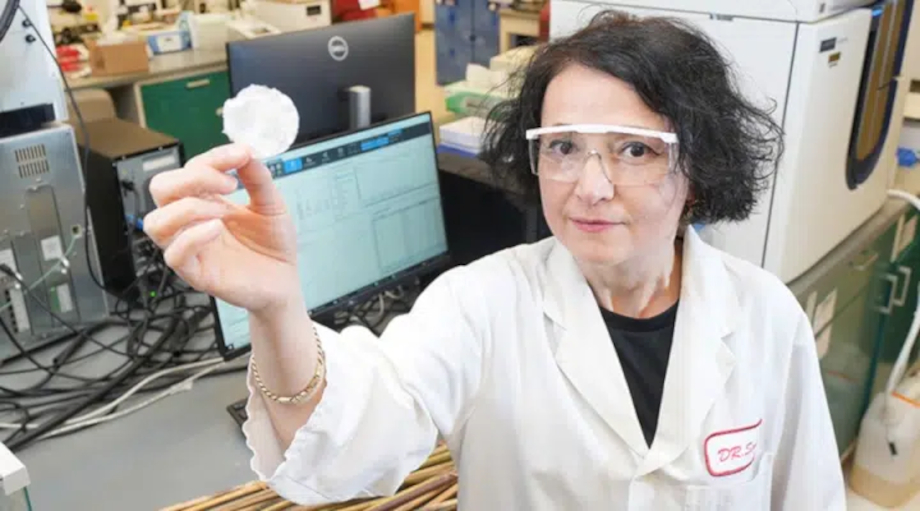Purdue University researchers say they are using cellulose extracted from industrial hemp to develop biodegradable superabsorbent materials that will be less polluting than those now used in disposable diapers, feminine hygiene products, agricultural water retainers and other applications.
The widespread use of traditional non-renewable, non-biodegradable, petroleum-based absorbents has created environmental problems which are exacerbated by the significant energy required for their production, according to Senay Simsek, who heads the university’s Department of Food Science and is leading a team of researchers in the hemp project.
“Hemp hurds, found in the inner woody core of the hemp stalk, are highly absorbent due to their high cellulose content and low lignin levels. This makes them an excellent alternative for superabsorbent applications,” Simsek said.
Unique molecular structure
The cellulose extracted from hemp fibers is ideal for products requiring high absorbency because its molecular structure can be modified to boost its water retention capabilities, according to Simsek. Hemp bast fibers, the stringy fibers on the outer core of hemp plant stems, while less absorbent, provide strength and durability, she added.
Simsek said the Purdue process to refine the cellulose extracted from hemp involves a carefully designed sequence of treatments that first break down the natural structure of the material, increasing its surface area and porosity, like “turning a compact sponge into a more open, fluffy one.”
“The uniqueness of our technology lies in its versatility, making it highly tunable for diverse applications of superabsorbent materials across various industries,” Simsek said.
Other uses
Along with diapers and hygiene products, the Purdue-developed hemp material could also be used in additives that help soil retain water, offering a sustainable alternative to traditional superabsorbents that can harm the soil and retard plant growth, according to Simsek. “Our approach conserves water and supports the ecosystem by providing a biodegradable solution that integrates seamlessly into natural cycles,” she said.
Hemp-based absorbents can also be applied to biosensors used in a variety of industries, such as glucose strips and pregnancy tests, Simsek said. “The versatility stems from the material’s ability to respond dynamically to environmental changes. This trait is essential for timely and accurate biosensing,” she said.
Environmental challenge
The waste from used, non-biodegradable disposable diapers alone is impacting the planet’s health, according to the World Economic Forum, which reported in August 2023 that more than 300,000 disposable diapers are incinerated or taken to landfills each minute, and that billions of menstrual pads and tampons are discarded annually in the U.S. alone.
In addition to environmental concerns, the production of absorbents based on petroleum leads to the depletion of limited resources and ties those products to fluctuating oil prices and geopolitical tensions, Simsek said.
Huge $$ opportunities
Simsek said the next step to bring the superabsorbent materials to the market is to scale up the technology to industrial levels.
“This scaling phase is vital not only for refining our process but also for demonstrating the practical applications of our innovation in agriculture and food packaging, areas where sustainable solutions are urgently needed,” she said.
The opportunities for such materials are vast. The global disposable diaper market was estimated to be worth around $80-90 billion in 2023, while the feminine hygiene products market, including tampons, sanitary pads, and liners, is projected to reach $50-55 billion by 2025. The combined market size for biosensor glucose strips used by diabetics and home pregnancy tests was estimated to be around $20-25 billion globally last year.
The agricultural water retainer market is a relatively smaller segment estimated at around $500 million to $1 billion, but with increasing concerns about water scarcity and growing adoption of sustainable agricultural practices, the market is expected to see significant growth in the coming years.
Patents sought
The superabsorbent hemp-based materials being developed at Purdue have been submitted to the university’s commercialization office, which has applied for a patent from the U.S. Patent and Trademark Office.
The Purdue hemp research team received seed funding through the College of Agriculture’s Agricultural Science and Extension for Economic Development program, an internal grants competition that supports plant and animal agriculture and rural development.

